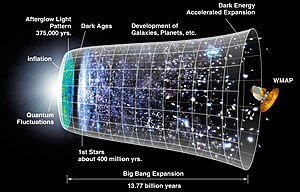World's biggest scientific experiment "Big Bang"
The well-known Welshman physicist, Lyn Evans, dubbed Evans the Atom, will this week switch on a giant particle accelerator designed to unlock the secrets of the Big Bang.
What is big bang?
The Big Bang is the cosmological model of the universe that is best supported by all lines of scientific evidence and observation. The essential idea is that the universe has expanded from a primordial hot and dense initial condition at some finite time in the past and continues to expand to this day. Georges Lemaître proposed what became known as the Big Bang theory of the origin of the Universe, although he called it his 'hypothesis of the primeval atom'. The framework for the model relies on Albert Einstein's General Relativity as formulated by Alexander Friedmann. After Edwin Hubble discovered in 1929 that the distances to far away galaxies were generally proportional to their redshifts, this observation was taken to indicate that all very distant galaxies and clusters have an apparent velocity directly away from our vantage point. The farther away, the higher the apparent velocity.[1] If the distance between galaxy clusters is increasing today, everything must have been closer together in the past. This idea has been considered in detail back in time to extreme densities and temperatures, and large particle accelerators have been built to experiment on and test such conditions, resulting in significant confirmation of the theory. But these accelerators can only probe so far into such high energy regimes. Without any evidence associated with the earliest instant of the expansion, the Big Bang theory cannot and does not provide any explanation for such an initial condition, rather explaining the general evolution of the universe since that instant. The observed abundances of the light elements throughout the cosmos closely match the calculated predictions for the formation of these elements from nuclear processes in the rapidly expanding and cooling first minutes of the universe, as logically and quantitatively detailed according to Big Bang nucleosynthesis.
While the Big Bang model is well established in cosmology, it is likely to be refined in the future. Little is known about the earliest moments of the universe's history.
Image from WMAP press release, 2006.
Watch video
http://broadband.indiatimes.com/showvideo/3465964.cms
Check out LHC(large hadron collider machine) First Beam - 10th September 2008 - 9am CEST (GMT+2)
Live webcasts are available in Windows Media and Flash format from
http://webcast.cern.ch/
or check out more videos
Indian time 12:30 scientists will switch on the world's largest particle accelerator in an attempt to recreate the conditions which existed just after the Big Bang, which created the universe.
Built by the European Organisation for Nuclear Research (CERN), the collider lies beneath the French-Swiss border, near the institution's headquarters in Geneva, at depths ranging from 170 feet to 600 feet.
But a handful of scientists believe that the experiment could create a shower of unstable black holes that could "eat" the planet from within, and they are launching last-ditch efforts to halt it in the courts.
One of them, Otto Rossler, a retired German chemist, said he feared the experiment may create a devastating quasar - a mass of energy fuelled by black holes - inside the earth. Jets emanating from it would grow and catastrophes such as earthquakes and tsunamis would occur at the points they emerged from the earth.
"The weather will change completely, wiping out life, and very soon the whole planet will be eaten in a magnificent scenario - if you could watch it from the moon. A Biblical Armageddon. Even cloud and fire will form, as it says in the Bible."







